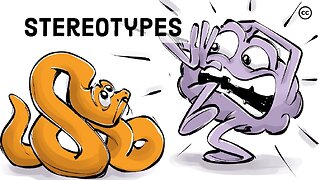14 - Perception of Gender Talk Frequency - Biases and Communication Styles
Dive into "Perception of Gender Talk Frequency: Biases and Communication Styles", an insightful exploration of the biases influencing perceptions of gender discussions frequency. We delve into psychological phenomena such as selective attention and confirmation bias that shape our viewpoints on gender dynamics. Unpacking intriguing research, we discuss different communication styles and how they can skew perception of frequency in gender discussions. The conversation aims to foster understanding and promote healthier communication between sexes.
#genderdynamics #biases #communicationstyles #malefemaledynamics #genderdiscrimination #psychology #selectiveattention #confirmationbias #gendertalkfrequency #socialnorms #stereotypethreat #genderroles
References for Further Reading:
Blakemore, J. E. O., Berenbaum, S. A., & Liben, L. S. (2014). Gender Development (1st edition). Psychology Press.
Cherry, K. (n.d.). How We Use Selective Attention to Filter Information and Focus. Verywell Mind. Retrieved August 22, 2023, from https://www.verywellmind.com/what-is-selective-attention-2795022
Connell, R. W., & Messerschmidt, J. W. (2005). Hegemonic Masculinity: Rethinking the Concept. Gender & Society, 19(6), 829–859. https://doi.org/10.1177/0891243205278639
Eagly, A. H., & Wood, W. (1991). Explaining Sex Differences in Social Behavior: A Meta-Analytic Perspective. Personality and Social Psychology Bulletin, 17(3), 306–315. https://doi.org/10.1177/0146167291173011
Eagly, A. H., & Wood, W. (2012). Social Role Theory. In P. Van Lange, A. Kruglanski, & E. Higgins, Handbook of Theories of Social Psychology (pp. 458–476). SAGE Publications Ltd. https://doi.org/10.4135/9781446249222.n49
Ellemers, N. (2018). Gender Stereotypes. Annual Review of Psychology, 69(1), 275–298. https://doi.org/10.1146/annurev-psych-122216-011719
Fine, C. (2011). Delusions of Gender: How Our Minds, Society, and Neurosexism Create Difference (Reprint edition). W. W. Norton & Company.
Fiske, S. T. (2018). Stereotype Content: Warmth and Competence Endure. Current Directions in Psychological Science, 27(2), 67–73. https://doi.org/10.1177/0963721417738825
Hall, J. A. (2011). Sex differences in friendship expectations: A meta-analysis. Journal of Social and Personal Relationships, 28(6), 723–747. https://doi.org/10.1177/0265407510386192
Hyde, J. S. (2014). Gender Similarities and Differences. Annual Review of Psychology, 65(1), 373–398. https://doi.org/10.1146/annurev-psych-010213-115057
Nickerson, R. S. (1998). Confirmation Bias: A Ubiquitous Phenomenon in Many Guises. Review of General Psychology, 2(2), 175–220. https://doi.org/10.1037/1089-2680.2.2.175
Pettigrew, T. F., & Tropp, L. R. (2006). A meta-analytic test of intergroup contact theory. Journal of Personality and Social Psychology, 90(5), 751–783. https://doi.org/10.1037/0022-3514.90.5.751
Rippon, G. (2019). The Gendered Brain: The new neuroscience that shatters the myth of the female brain.
Sibley, C. G., & Barlow, F. K. (2009). Ubiquity of Whiteness in majority group national imagination: Australian = White, but New Zealander does not. Australian Journal of Psychology, 61(3), 119–127. https://doi.org/10.1080/00049530802239300
Tannen, D. (1996). Gender and Discourse. Oxford University Press.
Vandello, J. A., & Bosson, J. K. (2013). Hard won and easily lost: A review and synthesis of theory and research on precarious manhood. Psychology of Men & Masculinity, 14(2), 101–113. https://doi.org/10.1037/a0029826
Zosuls, K. M., Miller, C. F., Ruble, D. N., Martin, C. L., & Fabes, R. A. (2011). Gender Development Research in Sex Roles: Historical Trends and Future Directions. Sex Roles, 64(11–12), 826–842. https://doi.org/10.1007/s11199-010-9902-3
-
 10:12
10:12
BornMoguls
3 months agoThe #1 Reason Men Don't Approach Women In 2024 (Reaction to F&F Podcast)
19 -
 7:17
7:17
Information for Life - Insights and Ideas to Navigate Your World
4 months ago55 - Assets or Liabilities - The Impact on Relationships & Fostering Healthier Connections
16 -
 2:40:24
2:40:24
Bored Kanack
3 months agoTalking to Vanta the Sybarite (@VantasChannel ) on the causes and solutions to male loneliness
761 -
 0:05
0:05
MindBlownFacts
4 months agoMale Psychology Exposed: Understanding the Male Mind
7 -
 6:59
6:59
101
5 months ago🤫 Inside the Mind of Quiet Individuals: Unveiling Psychology Facts | ElevatePsychology 🤔
2 -
 48:30
48:30
JLenardDetroit
5 months ago(CTP S1E28) SneakPeek/BTS "Can One 'Generalize' About Women Voters?" (Audio Show drops 20231230)
222 -
 5:20
5:20
101
5 months ago🚫 Unlocking Dating Success: Overcoming 6 Factors That Make You Less Attractive @ElevatePsychology
16 -
 10:22
10:22
Austin_Creed
2 months agoWomen Naturally Lie to Men
14 -
 3:33
3:33
Sprouts
3 months agoStereotypes: The Truth Behind Cultural Clichés
373 -
 1:00:15
1:00:15
reactforhope
6 months agoGender Dysphoria & ASD: A Scientific Discussion
1.82K